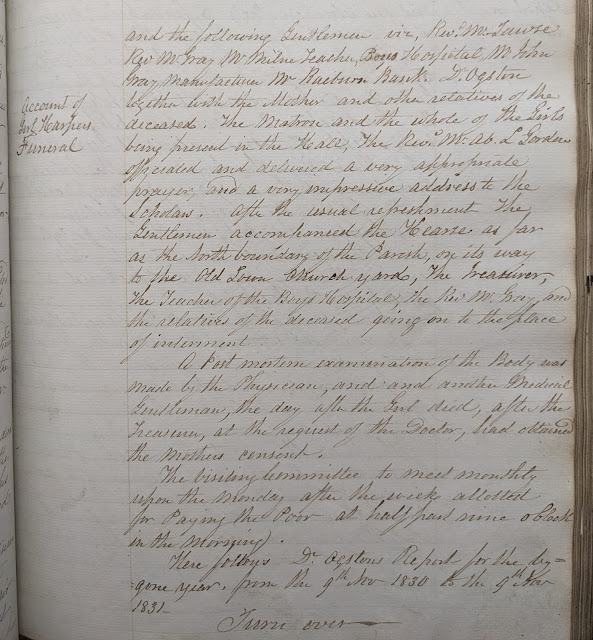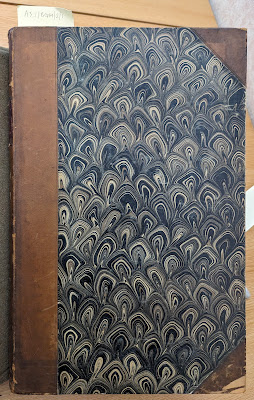Within the Walls of the Aberdeen Boys' & Girls' Hospital
The formation of the Boys’ Hospital was born out of the Aberdeen Poor’s Hospital, which provided residential places for destitute children from 1741. In 1818 the Boys’ Hospital was founded and situated in the Gallowgate until they moved to a new building in the Upperkirkgate in 1829.
The Gallowgate premises became home to the newly founded Girls’ Hospital, established in 1828.
 |
| Circular from AET/BGH/2/1 - Girls' Hospital, Aberdeen: Minute Book, 1828 - 1851 |
This institution was funded by subscriptions from locals as well as those out-with Aberdeen; by July 1828 the managers had accrued over £1269. The Hospital opened its doors in 1829 and welcomed in 20 girls who were dependent on the Poor’s Hospital funds. The girls had to be children “of parents domiciled in the old parish of Saint Nicholas only”. They also had to be under the age of 7 and no older than 10 to be deemed eligible for admission. The children were instructed in reading, writing, arithmetic, knitting, sewing and all other necessary domestic concerns. Upon reaching the age of 14 the girls were expected to leave the Hospital and find work, usually as domestic servants. Prior to its official opening, the managers of the Girls’ Hospital advertised a vacancy for a matron in the local newspapers:
Matron wanted for
the Girls’ Hospital Aberdeen: an unmarried woman, or a widow without any child;
not under 30, nor above 45 years of age, and a member of the Established Church
of Scotland. She must be able to teach reading, writing and arithmetic and
possess an adequate knowledge of knitting… and other needlework.
Mrs Elspet Hay, widow of John Hay (shipowner and merchant), was employed as the first matron of the Girls’ Hospital in April 1829 at a salary of £20 per year. This was later increased to £30. A maid servant, male teacher and resident physician were also appointed. The first male teacher at the Girls’ Hospital was Mr Tawse, whose salary totalled £10 per year (later increased to £15). Dr Francis Ogston (1803-1887) was unanimously elected by the managerial committee as resident physician and earned a sum of £5 per year. Later in 1831, a teacher of church music was appointed with a yearly salary of £1.
 |
| AET/BGH/2/1 - Girls' Hospital, Aberdeen: Minute Book, 1828 - 1851 |
On 27th July 1829, 17 girls were admitted:
 |
| AET/BGH/2/1 - Girls' Hospital, Aberdeen: Minute Book, 1828 - 1851, extract 1829 |
These were:
- Hannah Brown aged 6 ½ years, born 20th February 1823 - daughter of David Brown, late Town Drummer (I discovered David's application for the vacancy of Town Drummer while cataloguing material from the Charter Room, if you are interested it can be accessed using the reference CA/8/P/35/53).
- Ann Downie aged 6, born 20th April 1823 - in 1833 was sent to the country for the benefit of her health as she was unable to learn lessons due to “mental incapacity and unhealth in the body”. The managers decided to put her in the charge of the United Fund and have someone act as her guardian as she had no known friends or relatives.
- Margaret Low aged 10, born in July 1829 - left the Hospital in March 1831 and went into service at the household of Mr Brown in Mill of Williamston in Inverurie.
- Christian Low aged 8, born in August 1822 - left the Hospital in April 1835 to go to service in the household of Mr Peter McFarlane.
- Mary Ann Mavor aged 8 - left the Hospital in April 1833 and went into service for Mrs Thomson who was a baker in the Gallowgate.
- Eliza Williamson aged 9 - left the Hospital in December 1832 to go into service for Mr Scotsman who was a sailor and resided at 4 Hanover Street. In February 1836, Eliza was awarded a premium for good behaviour and over 4 years’ good service.
- Isabel Williamson aged 8 - left the Hospital in June 1833 to go into service for a painter named Mr Giles.
- Jean Wilson aged 10- left the Hospital in October 1832 to go to service in the household of Mr Brown at Williamston, Inverurie.
- Williamina McGarvie aged 6 - her father was transported and her mother was noted as “weakly”. Williamina left the Hospital in 1836 to go into service.
- Elizabeth Cummine aged 9, born 22nd May 1820 - daughter of James Cummine, deceased and her mother “unable to maintain her”. Left the Hospital in November 1834 to go into service. Elizabeth was rewarded for good service in 1837 with a premium of 1 guinea.
- Mary Allan aged 7, born 4th August 1829 - daughter of William Allan who was a Flaxdresser, deceased. According to the Managers’ Minute Book, Mary ran away from the Hospital twice. Her mother did not want her daughter to stay with her so quickly returned her to the Hospital and instructed the matron not to let her come back. A meeting was set up to decide what should be done regarding her conduct. Her mother stated that her daughter gave no reason for leaving the Hospital barring the issue of confinement (due to outbreaks of cholera in the city, the girls were forbidden to leave the grounds of the Hospital). On Mary's last attempt to leave the Hospital, she told her mother that she would not go back. As a result of her behaviour, Mary was dismissed from the Hospital by the managers.
- Ann Eddie aged 7, born 15th March 1829 - Ann was expelled from the Hospital in October 1832 after running away with another girl (Eliza McLeod - she was admitted later than the first 17 girls in the list) who was also dismissed. Ann ran away to a house in Peacock’s Close, belonging to a baker named Mr Middleton. The matron found her there and Ann refused to come back. The decision was made to expel her due to her bad behaviour.
- Hannah White aged 12 - this is an interesting case as Hannah was well above the maximum age for admission. Hannah was removed from the Hospital by “her friends with consent of the committee” in June 1831.
 |
| AET/BGH/2/1 - Girls' Hospital, Aberdeen: Minute Book, 1828 - 1851, extract 1831 |
- Eliza Bain aged 10, born 2nd May 1819 - father unknown and her mother Janet Smith was born in Aberdeen. Went into service in the household of Mrs Henry in September 1832 (see below)
 |
| AET/BGH/2/1 - Girls' Hospital, Aberdeen: Minute Book, 1828 - 1851, extract 1832 |
- Margaret Leask aged 8 - daughter of James Leask who worked as a Tailor, mother unknown; both parents deserted their children. Margaret left the Hospital in 1836 to go into service.
- Mary Gray aged 6, born 22nd December 1823 - daughter of the deceased James Gray, Sailor. Her mother presented her for admission to the committee.
- Amelia Byres aged 6, born 22nd June 1823 - daughter of the deceased Alexander Byres, Sailor. Presented to the committee for admission by her mother. In 1832, Amelia was sent to the country for the benefit of her health for a few months. In June 1833, it was decided that she should be sent to live with her mother due to her labouring under the disease known as scrofula. Scrofula (tuberculosis lymphadenitis) was known as ‘the King’s evil’ in Europe where it was believed that a royal touch could cure the disease.
The girls were provided with clothing which included: a frock of dark cotton stripe, a dark blue petticoat, a slip with a checked pattern, caps of bleached dowlas (plain cloth) and a rustic straw bonnet. Their shifts (night gowns) were made of bleached plain linen, their worsted stockings were of a dark colour and the girls had the choice of laces or straps on their shoes. The uniform made the girls easily identifiable, which would come in handy when faced with runaways (which happened quite often!)
 |
| AET/BGH/2/1 - Girls' Hospital, Aberdeen: Minute Book, 1828 - 1851, extract on clothes |
Mary Harper (1822-1831)
Mary was admitted into the Hospital aged 8 in September 1830. Her father William, a Sailor, was deceased. Her mother was living at 19 Windy Wynd and would likely have decided her daughter was better off in the care of the Girls’ Hospital.
On 13th October 1831, the minute book records that Mary was reported as being unwell with a ‘gum boil.’ Her mother asked the matron for permission to stay in the Hospital and attend to her ailing child. The request was initially refused due to her mother’s unpleasant attitude towards staff at the Hospital, but she was eventually permitted to stay after she threatened to remove her child. It was resolved that she would be allowed to see her daughter everyday only in the presence of the physician. Mary Harper died on 20th October 1831, aged 9.
The physician’s report was copied into the minute book dated 30th November 1831. Ogston recorded that Mary was “first attacked by the gum boil” and afterwards suffered “inflammation of the lining membrane of the air passages, complicated with water in the chest and pulmonary consumption” which caused her death. Tuberculosis of the mouth can either be primary or secondary to pulmonary (this means that the disease has settled in the lungs) tuberculosis and can present itself in the form of painless boils or ulcers on the gums. This is the first recorded fatality in the Girls’ Hospital. The minute book also has an account of Mary's funeral procession and post-mortem exam which was performed with the consent of her mother
 |
| AET/BGH/2/1 - Girls' Hospital, Aberdeen: Minute Book, 1828 - 1851 - Mary Harper's funeral procession |
In January 1832, Aberdeen was
affected by an outbreak of cholera which is a water-borne pathogen. Although it
is not found in the UK today, cholera wreaked havoc on our ancestors. The
disease causes extremely unpleasant symptoms and can infect a person if they
consume unclean water. The disease affects the small intestine, and the
magnitude of symptoms can range from mild to severe. According to the WHO,
cholera originated in the Ganges on the Indian subcontinent. From there it
spread across the globe during the nineteenth century. At present, oral
vaccinations are used in the fight against cholera. The disease was first
mentioned as early as 1642 by Dutch physician Jakob de Bondt. Dr Ogston
instructed that the girls should be confined to the grounds of the Hospital for
their own safety. By June 1832, the disease was still rife within the city and
Dr Ogston recommended that the girls bathe in the sea to avoid infection. It
was not until February 1833 that the restrictions were lifted, and the girls
were allowed to go out and visit friends and family as they had previously
done.
Dr Ashleigh Black, Archive Assistant
[Records of the Boys’ & Girls’ Hospital have been catalogued as part of the Aberdeen Endowments Trust collection (reference AET/BGH) which took over the Boy’s & Girls’ Hospital in 1888. This includes a bound copy of the act of the Burgh Council establishing the Poor’s Hospital in 1739 (AET/BGH/7/1).]





Comments
Post a Comment